If you plan to go to Chile, especially if you plan to visit the whole country, make sure you take with you wardrobe for ALL seasons regardless of the time of the year! Precisely because of its position and the shape of the country, Chile has on its territory practically all climates at the same time, because it stretches from the driest desert in the world in the north to the permafrost in the south. In addition, as a very dear Chilean friend of mine who lives in Belgrade has said, during my visit, I actually visited three continents – South America, Antarctica, as well as Oceania, since Easter Island, although Chilean territory, belongs to this continent that is linked to Australia.
Thus, after a day’s walk around sunny and warm Santiago, Sneza and I went for a trip to Valparaiso and Viña del Mar, so we dressed lightly, but luckily we also had sweaters with us for when we reached the shores of the Pacific we encountered gloomy and chilly weather.
In fact, while we were on the coach heading for Valparaiso, at first going through flat terrain where we saw numerous vineyards, the sky was completely blue, but as we entered a hilly area and approached the Pacific, we started seeing clouds ahead of us. Once we reached the destination for the day, the sky above us was completely covered by clouds. Luckily, it did clear up after some time and it even became warmer.
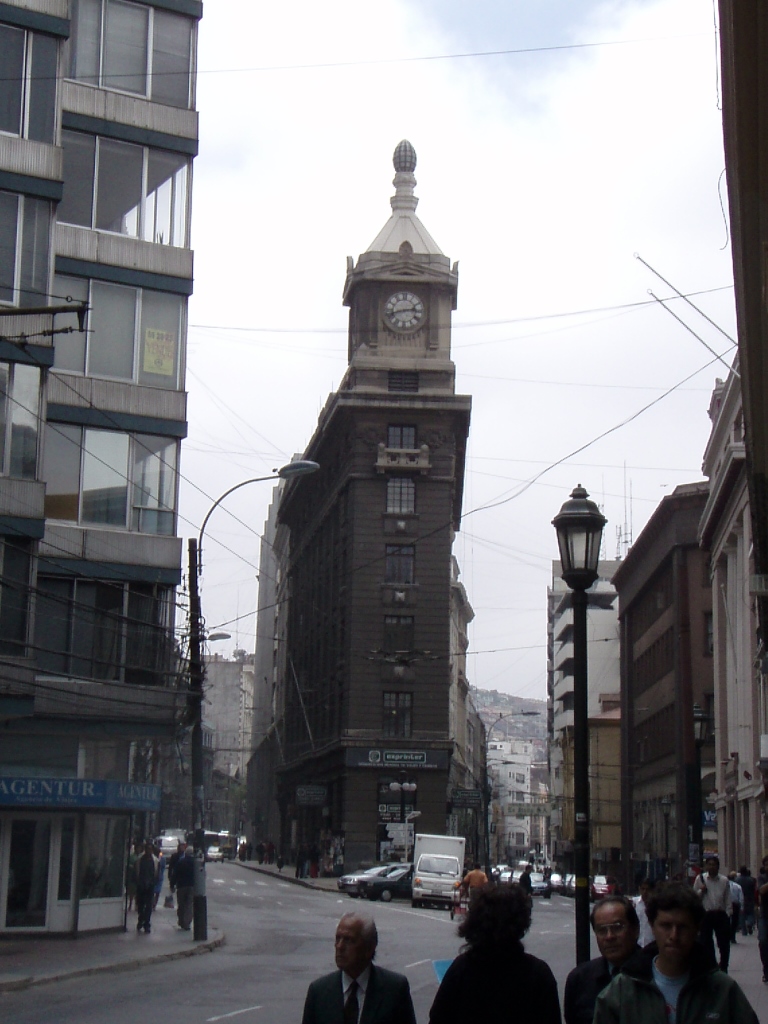 Valparaiso, the Turri building and clock
Valparaiso, the Turri building and clock
Valparaiso, which is some 150 km away from Santiago, is the second largest city in the country, but it is primarily a very important port. During the 19th century and at the beginning of the 20th century, it was an important point for commercial ships and it was then that the city had its major expansion which died out by the opening of the Panama Canal. Still, the historic centre of Valparaiso is the reason why this city is listed on the UNESCO’s World Heritage List.
What we first saw when we arrived in Valparaiso was the huge building of the Congress. After the orders of Pinochet, it was built in 1990 and the legislative branch of the country’s government was transferred here. Pinochet’s idea was to disperse the governance a little, as the executive branch (the Government) was certainly located in Santiago.
As opposed to the vast majority of the towns which the Spanish founded across Latin America and which by the rule have more or less the same ground plan (quadrangle central square and streets intersecting at right angles), Valparaiso has the distribution of streets as allowed by the local geography and in this case this means a relatively narrow flat belt along the ocean and then a steep ascent towards a ridge spreading above the Pacific, behind which there are numerous hills. Still, thanks precisely to this, at some point Valparaiso used to have over 20 funicular elevators built at the end of the 19th and the beginning of the 20th centuries, with less than ten used nowadays. One may spend almost an entire day visiting these funiculars and riding on them up and down, but Sneza and I visited the city only briefly and went by the principle “a little bit of everything,” including also buying some cotton T-shirts. They were cheap, nice and along our way, so we could not resist.
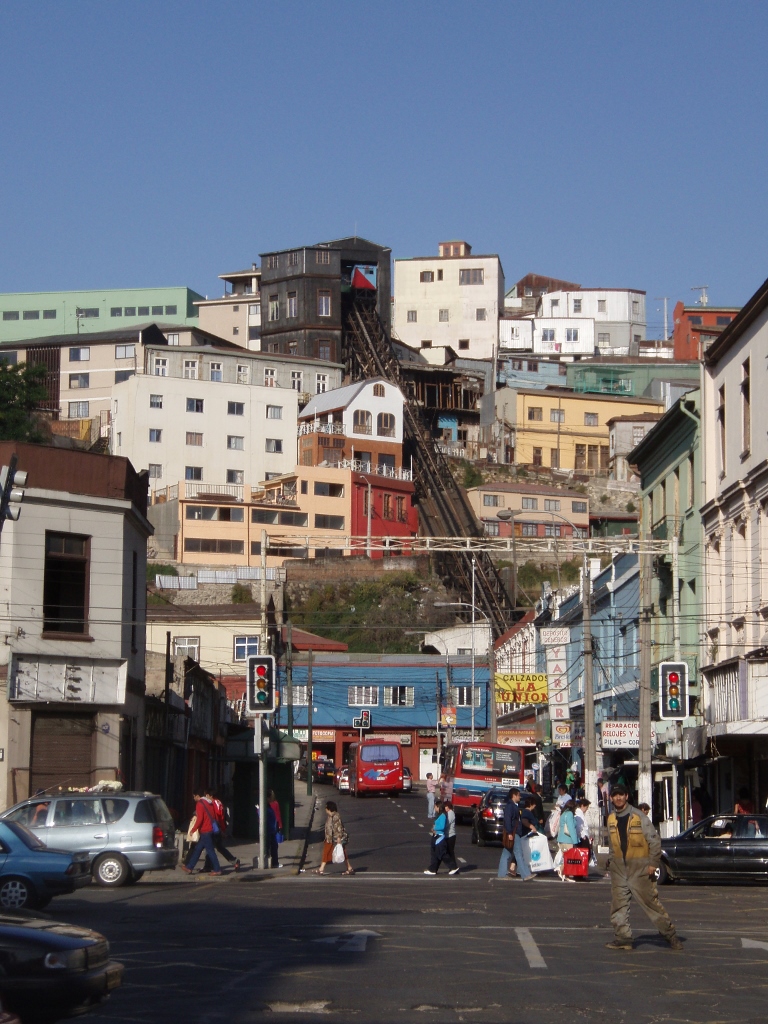 Valparaiso, the Baron funicular
Valparaiso, the Baron funicular
Owing to the limited time we had for the visit and enjoying of Valparaiso, we didn’t manage to go to the cemeteries. Namely, it is interesting that above the centre there are two graveyards called “The Catholic Cemetery” and “The Cemetery of Dissidents.” This first one is clear and it actually means that it is mostly Chileans who are buried there. This other has nothing to do with political opponents, although they have been quite numerous in the relatively recent history of Chile, but rather it has been intended for the English, Americans and members of many other nations who met their end in Valparaiso and were not catholic.
In fact, we first headed towards a funicular leading to Concepcion hill (Ascensor Cerro Concepcion), which is right next to the Turri building and clock, so this funicular is often called not after the hill it leads to, but simply by the name of Turri. The approach to the funicular leads through a narrow passageway between two buildings and the ride is short, but it was certainly interesting and easier than if we had climbed the hill on foot.
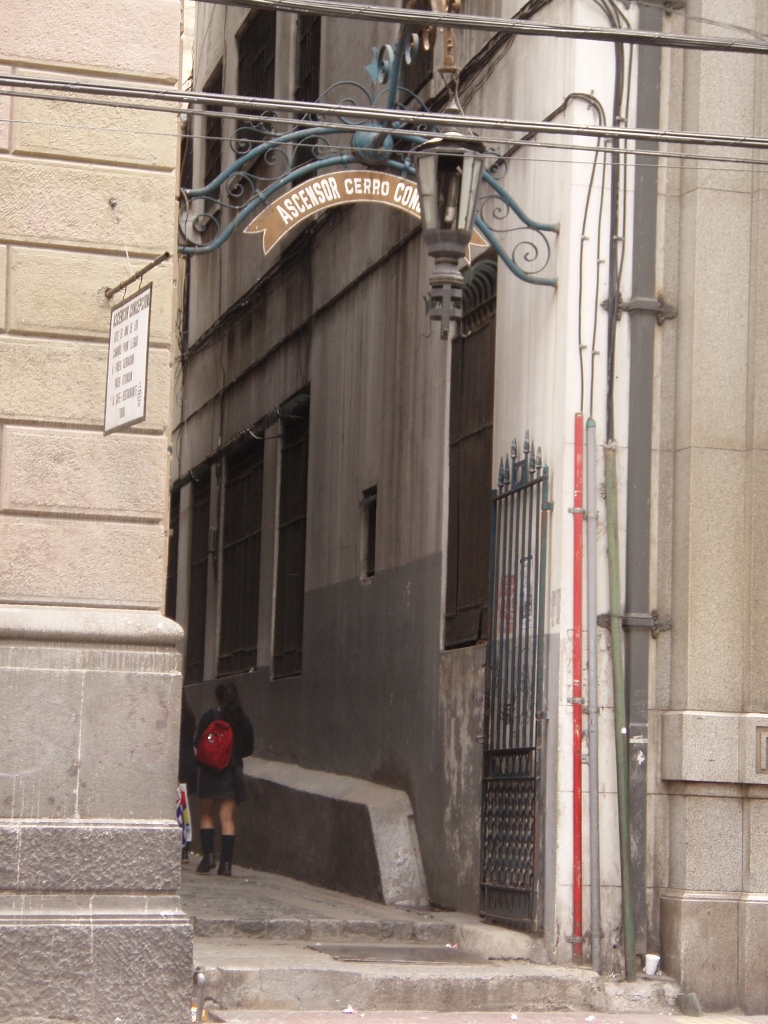 Valparaiso, the Concepcion funicular
Valparaiso, the Concepcion funicular
The view from the elevation is not particularly nice, because one may see the not-too-attractive port, but we certainly appreciated the idea of looking at the vast Pacific. Still, this part of the city is very cute and it contains numerous houses with facades painted in bright colours. The shape of the buildings is not particularly imaginative, but those motley facades render a particularly picturesque appearance, especially at first sight. Once you look at them more carefully, you may see that the houses are often covered by corrugated metal sheets. Sometimes, the ground floor is plastered, but the upper floor is covered by the metal sheets painted in the same colour as the plaster on the ground floor.
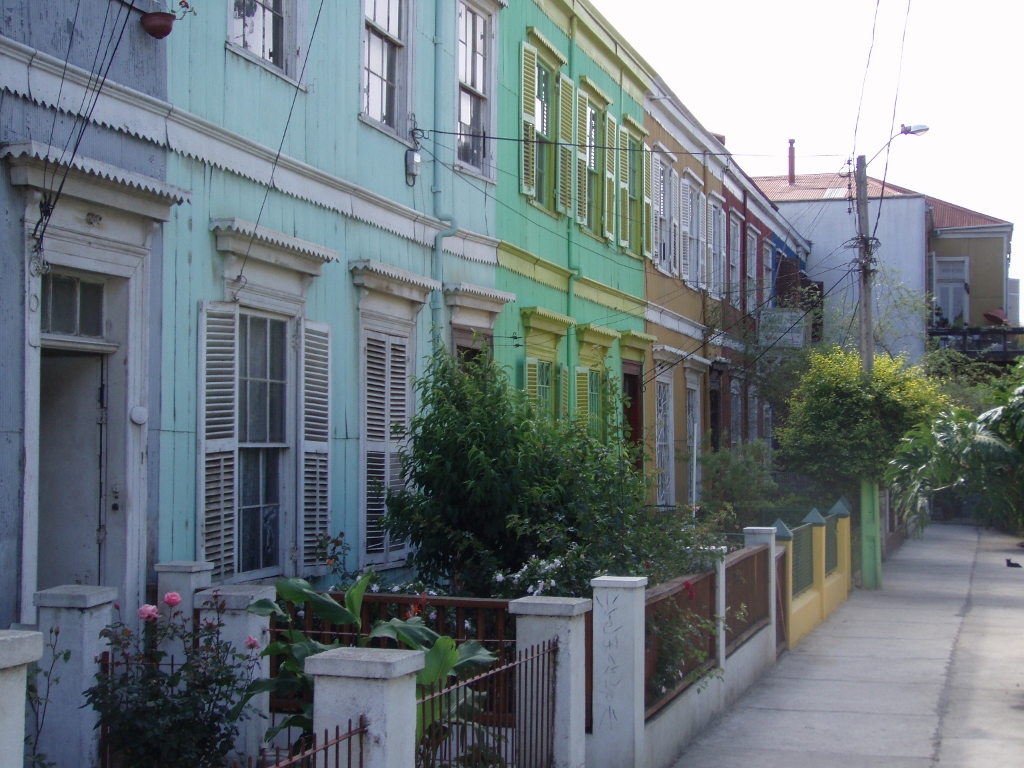 Valparaiso, cute houses on Concepcion hill
Valparaiso, cute houses on Concepcion hill
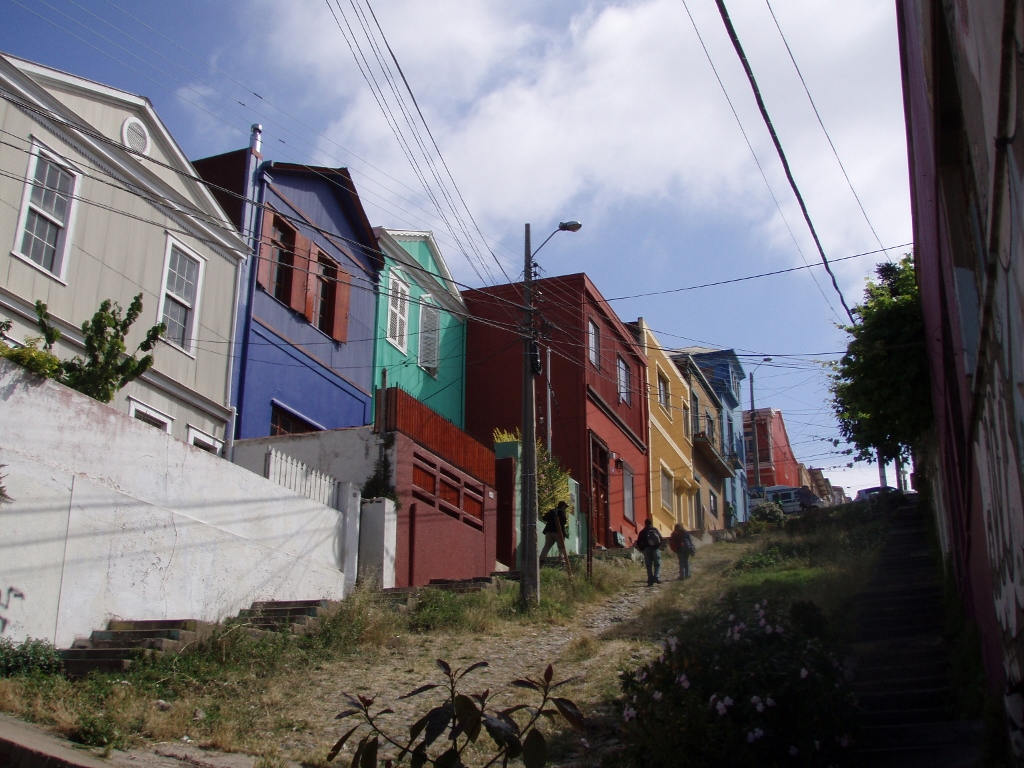 Valparaiso, cute houses on Concepcion hill
Valparaiso, cute houses on Concepcion hill
Of course, not all the buildings are this colourful, but those that are do stand out and appear quite pretty.
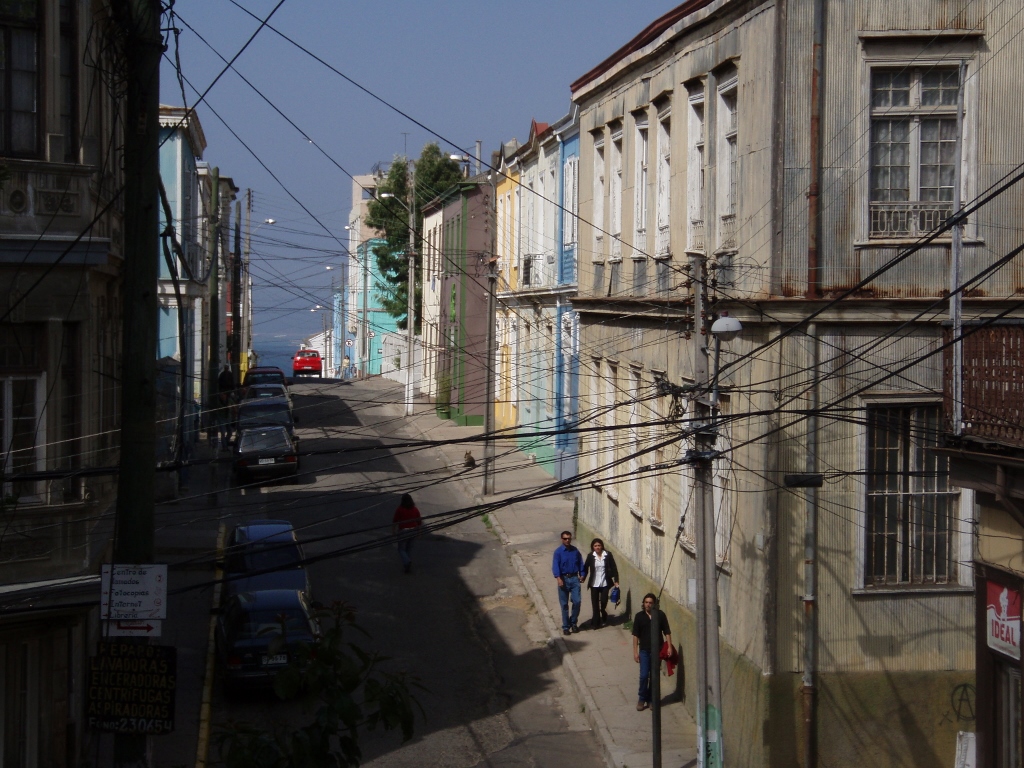 Valparaiso, a street on Concepcion hill
Valparaiso, a street on Concepcion hill
After a short walk and admiring the attractive colourful houses, we were ready for a break and lunch. We decided to go to a nearby restaurant that was recommended to us and there we sat on the terrace and had a wonderful meal while enjoying the by now clear sky. Both dishes that we ordered, and it is our habit to share food when we travel so that we may try more different dishes, were made of cusk-eels. It is used for preparing traditional Chilean fish stew, although I realized during my journey that everybody makes the stew differently. It didn’t matter. Each version I tried was very tasty.
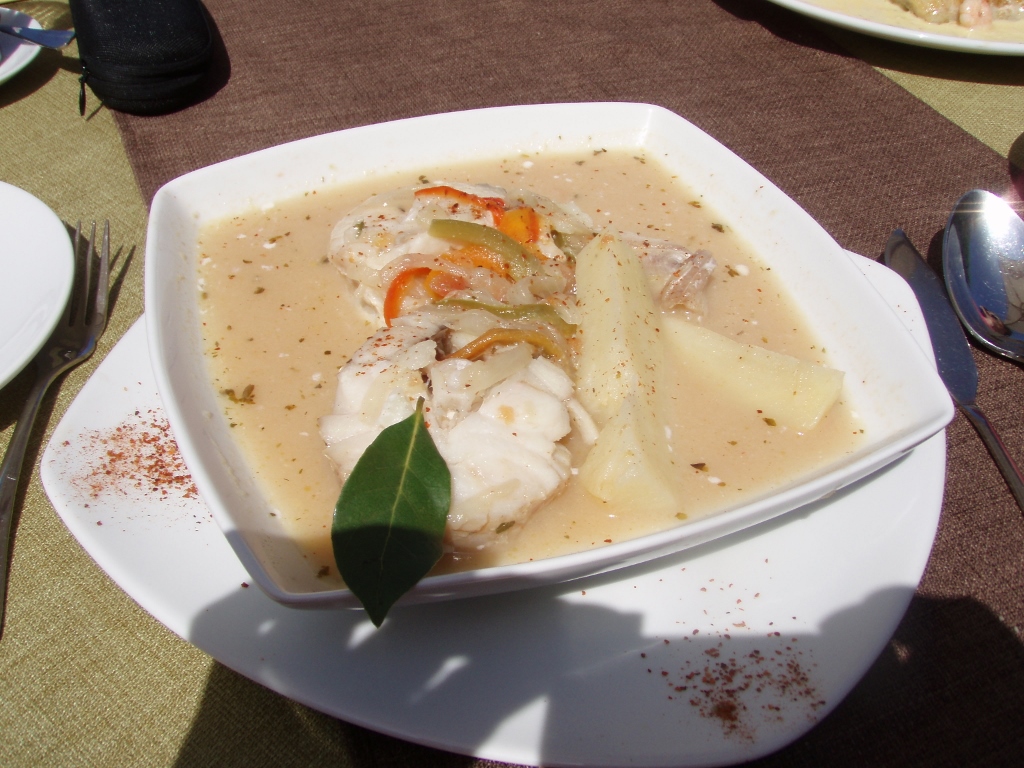 Valparaiso, sour and hot cusk-eel stew (Caldillo de Congrio)
Valparaiso, sour and hot cusk-eel stew (Caldillo de Congrio)
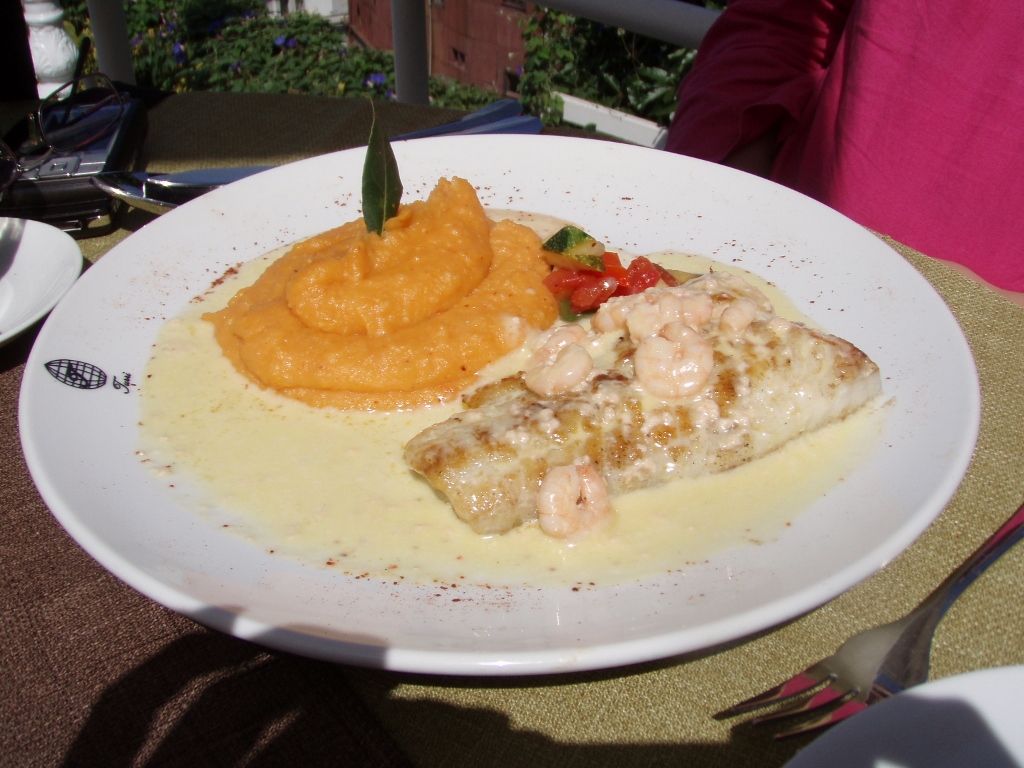 Valparaiso, grilled cusk-eel with spiced mashed potatoes (Congrio a la plancha con Pure Picante)
Valparaiso, grilled cusk-eel with spiced mashed potatoes (Congrio a la plancha con Pure Picante)
Following this tasty break, we continued with our walk along the elevation and thus we came to a small square that houses the Museo de Bellas Artes. The museum building itself is very attractive, but we found it particularly interesting when at the wall of the museum we saw the plaque with the name of the street. It displayed “Paseo Yugoslavo” street and all of this was taking place at the end of 2006, so at the time there was no country in the world under that name. Still, our amazement, as well as fun, did not end there. Under the present name of the street there was its former version – “Paseo Americano.”
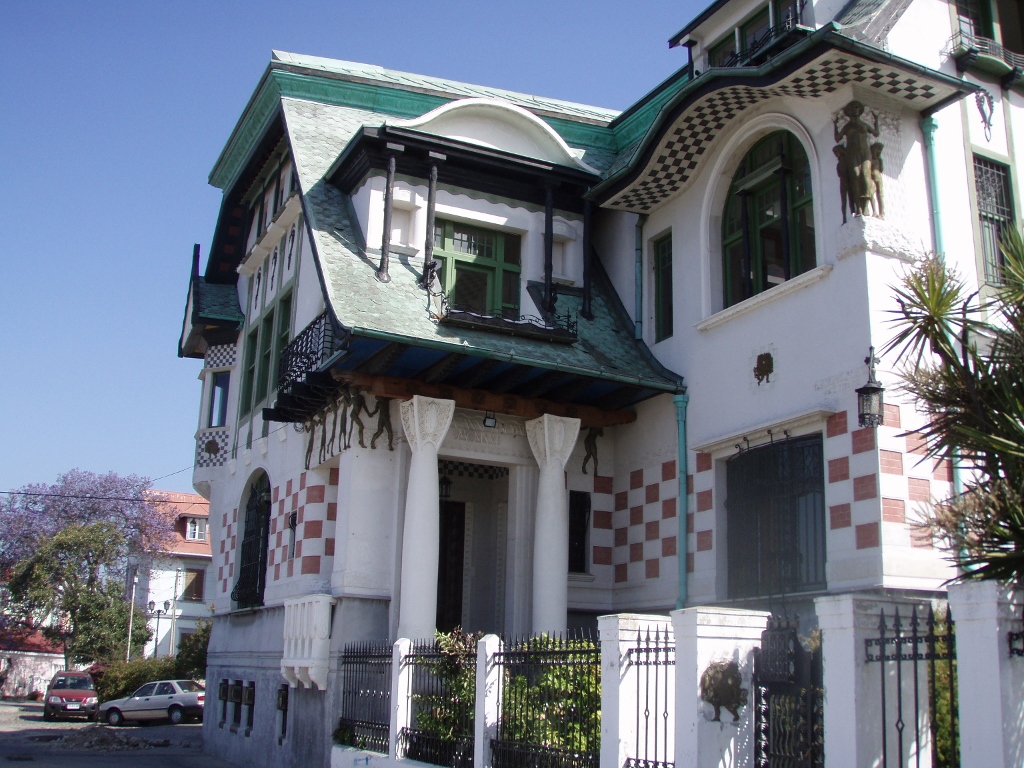 Valparaiso, Museo de Bellas Artes
Valparaiso, Museo de Bellas Artes
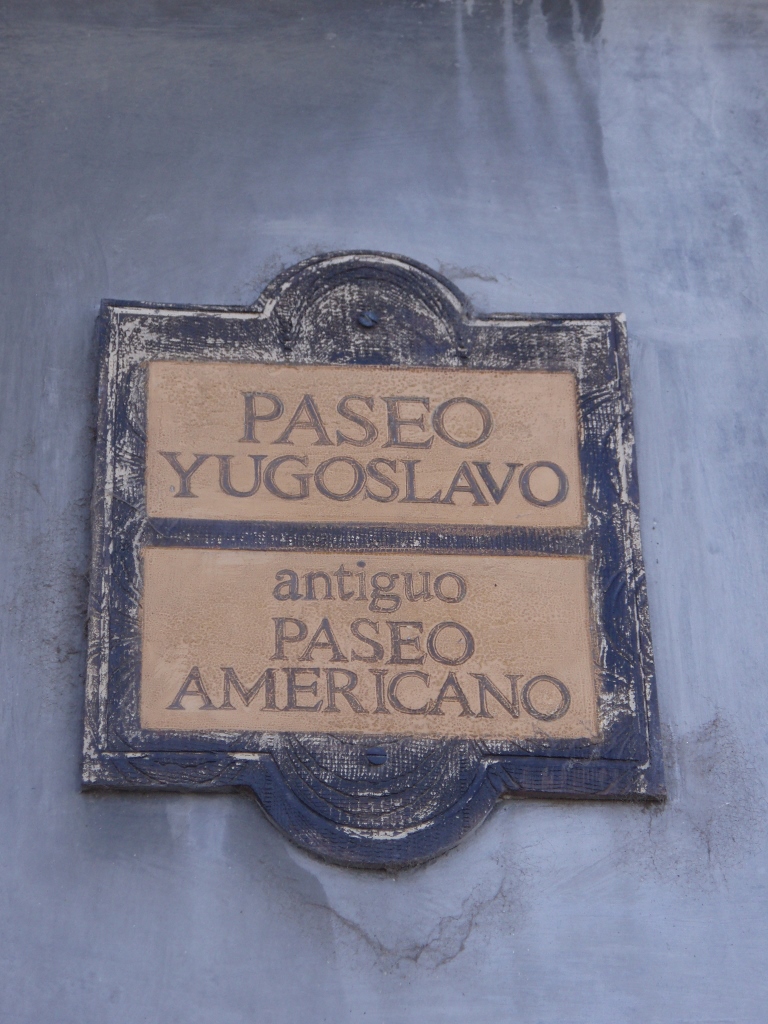 Valparaiso, plaque with the name of the street in which the Museo de Bellas Artes is located (year 2006)
Valparaiso, plaque with the name of the street in which the Museo de Bellas Artes is located (year 2006)
On one of the nearby hills it is possible to visit one of the houses that belonged to the famous poet Pablo Neruda who in 1971 won the Nobel Prize for literature. Other than being a great artist, he was also very much politically engaged and although he was already gravely ill, his sudden death in hospital some ten days after the coup d’etat in 1973 has also been subject to serious doubts and questions for decades. He, too, was exhumed within the scope of some investigations that were initiated in the recent years with the hope to get to the final findings. As far as I could get it, nothing reliable could be established.
From the elevation we took the El Peral funicular to get down to the Plaza Sotomayor which in fact is the main square in the city. There is a Monument to the Heroes of Iquique and there is also a building that belongs to a major insurance company which I particularly fancied on account of its quite simple, but interestingly fitted combination of the old and the new.
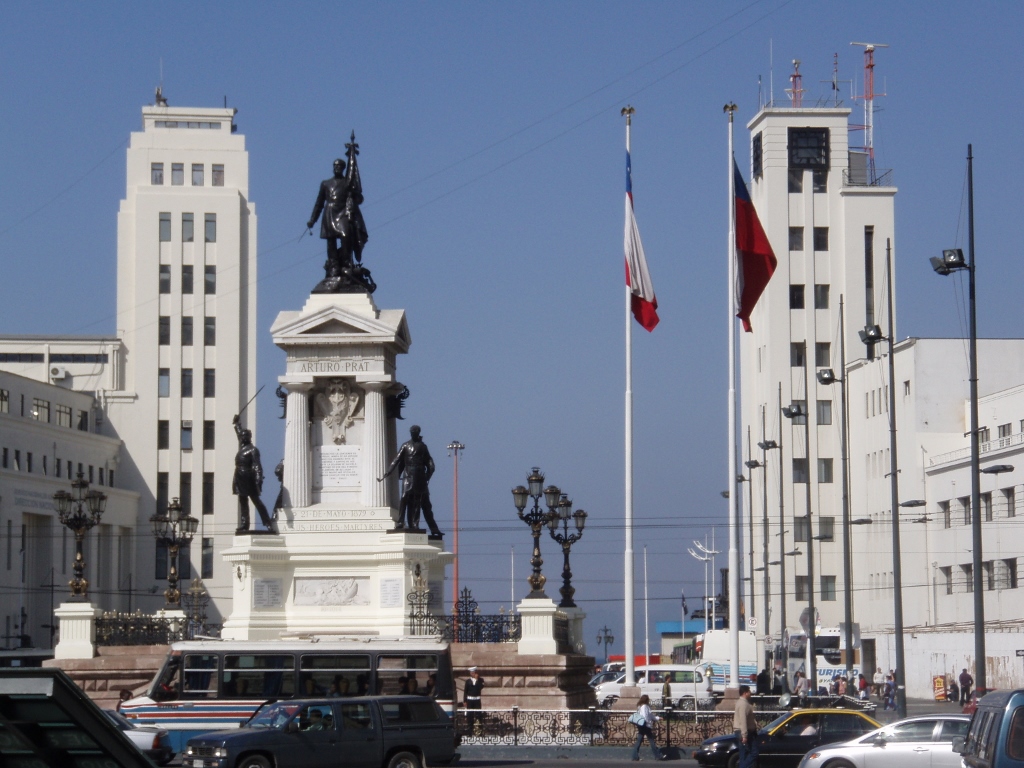 Valparaiso, Plaza Sotomayor, Monument to the Heroes of Iquique
Valparaiso, Plaza Sotomayor, Monument to the Heroes of Iquique
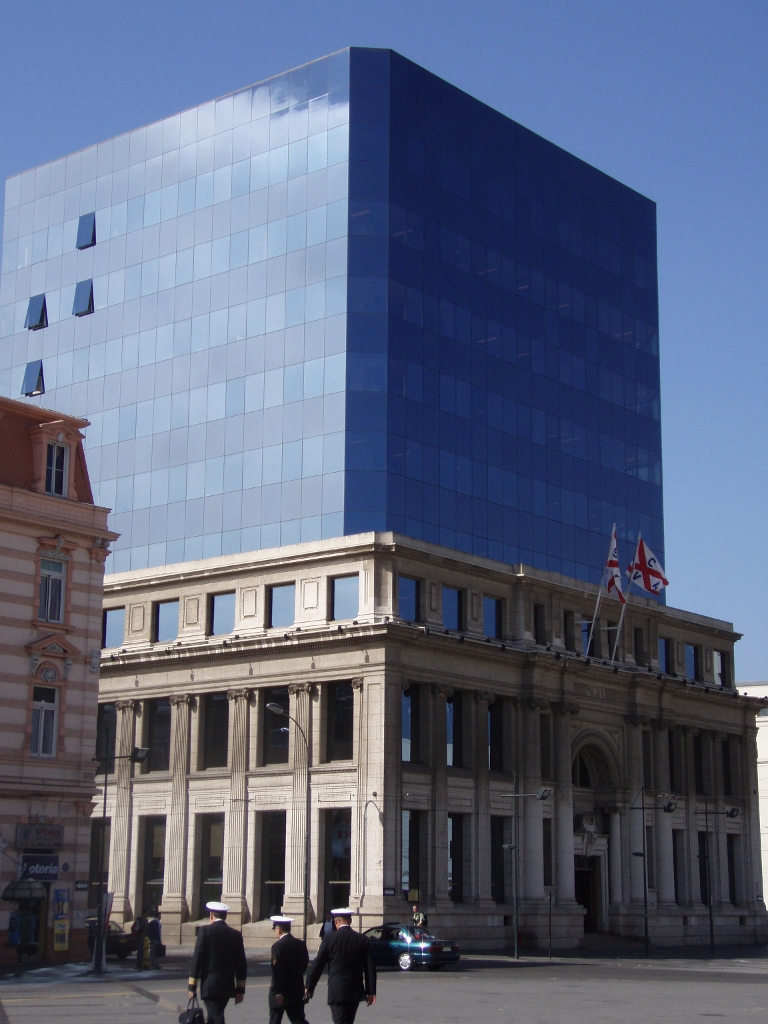 Valparaiso, an insurance company building
Valparaiso, an insurance company building
After coming down to the lower part of the city, we also went to a green market, but it did not appear exotic enough to keep us there for much longer, so we continued with the walk around Valparaiso, as it is quite a nice place that absolutely deserves a visit. Still, our visit that day was brief enough, since we soon moved to the nearby town of Viña del Mar.
Viña del Mar is a famous seaside resort. It is full of subtropical vegetation, but taking into account the cold waters of the Pacific that wash out on its beaches, this was not a resort according to our taste.
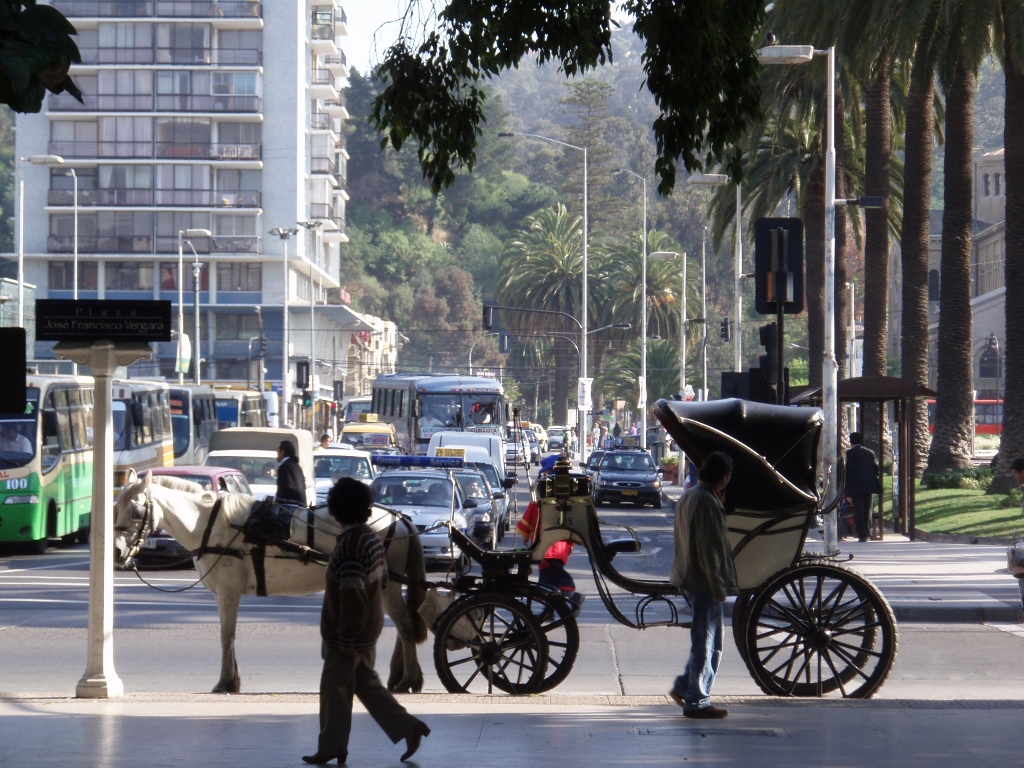 Viña del mar, a detail from the Vergara square
Viña del mar, a detail from the Vergara square
After a short period of time we spent in Viña del Mar, we first returned to Valparaiso and then to Santiago.
In Santiago we used underground to go to our flat and the whole underground transportation system is exceptionally well maintained and appears very nice. We were completely impressed when at the Moneda underground station we saw exhibited large-format paintings with motives from Chile. First we thought these were photographs or posters, but as it turned out these were proper paintings that constitute a permanent exhibition at this station. The author is Guillermo Muñoz Vera and we truly liked his realistic pieces, but we still looked at them with amazement, hardly believing that this was a proper art exhibit in such an odd place as an underground station.
So, as I’ve already said, in Chile you have to be prepared for all seasons. Thus, already the next day we flew to the town of Punta Arenas in the far south of the country and there we had to be well dressed for it was cold. Therefore – a warm jacket, a cap, gloves and the rest of it.
We arrived in Punta Arenas in the early afternoon and soon we settled at the house of a very kind woman whom I had never met before, but found her through internet, and who very kindly offered free stay at her house for both of us. When we arrived, she was not at home, there was one of her sons, but the plan was to get in touch with her and meet her downtown later. Namely, we were accommodated a little farther from the centre, but the place was more than excellent.
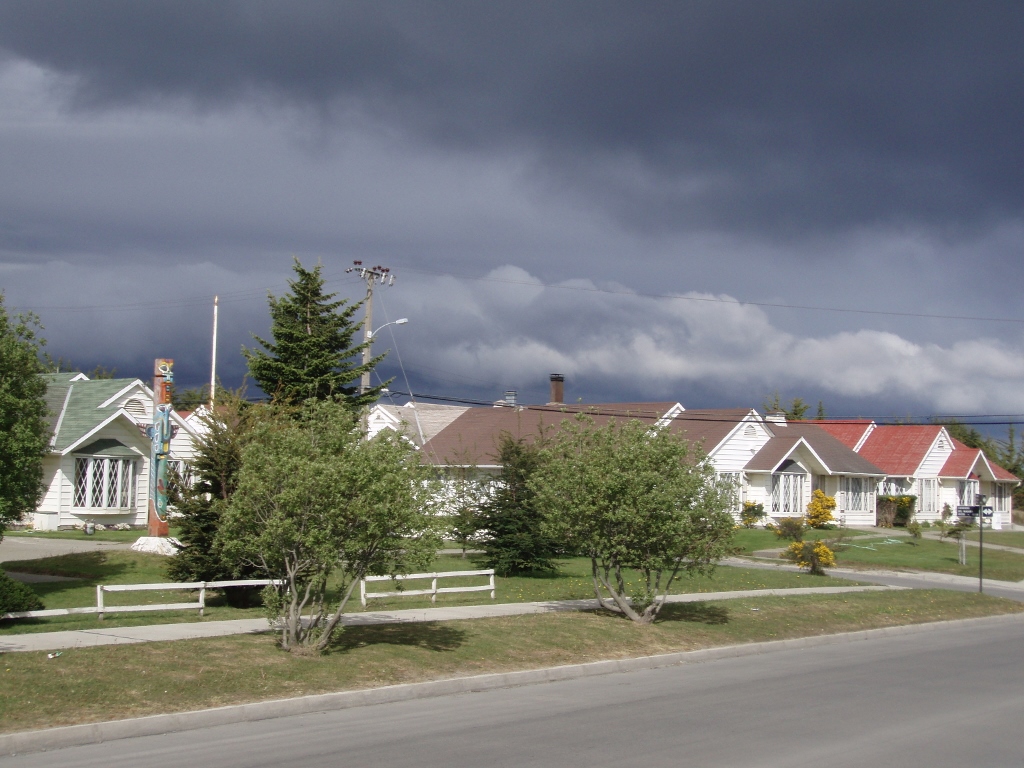 Punta Arenas, the neighbourhood in which we stayed
Punta Arenas, the neighbourhood in which we stayed
Very soon after our arrival, we headed for the centre of Punta Arenas using one of the numerous taxi collectivos that serve as public transportation. The taxi we got in had its specific route, which meant that we also enjoyed a mini-tour around Punta Arenas. Outside the centre of the town we mostly saw single floor houses and only few had an upper floor, while the architecture was also quite simple.
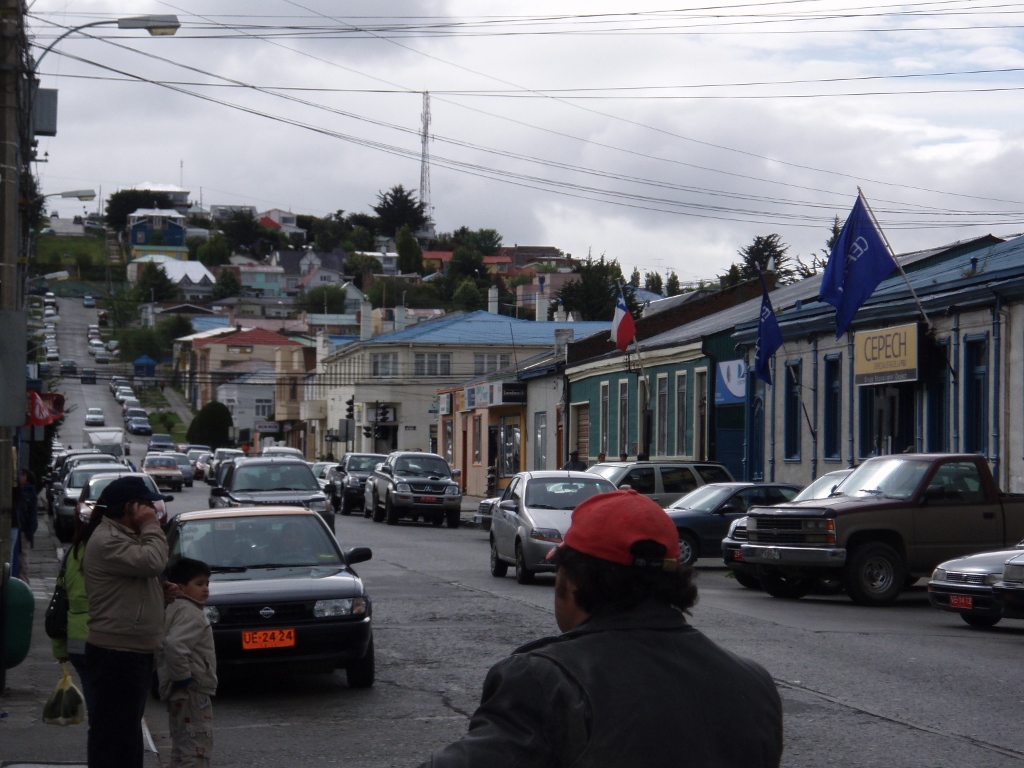 Punta Arenas, one of the typical streets
Punta Arenas, one of the typical streets
The reason why we were in a hurry to get to the centre was that we had a “job” to do there. Namely, Sneza and I were firmly set on going to Antarctica. If one wants to go to this continent, then Punta Arenas seems to be the ideal place, as this is the closest land from which one may visit it. There was an agency that organized an “excursion” to Antarctica with duration of two days. I had already contacted them and paid, but we still needed Sneza to pay for her share since we had already made the reservation. For all of these reasons, we had to get to the agency as soon as possible.
And that was what we did, everything was fine and settled, and we were soon out on the street again feeling a little hungry. However, we couldn’t find anything here around 5 o’clock in the afternoon, since the local population either has lunch or late dinner, while in between it is possible only to nibble something while walking. We had to content ourselves with vegetarian empanadas and chocolate, but we got in touch with our host and agreed to meet with her a little later, after her work, at a restaurant in the centre.
We used the free time we had for finding a tour that would take us to the Tierra del Fuego and the National Park Torres del Paine. We managed only to book the latter one, so we bought tickets to the town of Puerto Natales from where the visit to the national park was to leave a couple of days later.
By the time we had finished with all of this, we already had to go to the restaurant where we had set up the meeting with the unknown woman at whose house we would stay or leave our things while going on excursions over the next few days. We thought the easiest thing for meeting and recognizing one another would be if we all went to a restaurant, plus we were really quite hungry by then.
And we were right. As it turned out, Cecilia, for this was her name, was an EXCEPTIONALLY nice lady of similar age as Sneza and I, and we immediately started chatting as if we had known one another since who knows when. Along the way, she explained why there is no concrete food in restaurants around 5 pm. Namely, they call this part of the day “once” and this is when only snacks, coffee or tea are served, with no serious meal. And this I found completely logical and clear. Here is how.
At some point in my life, I worked for five years as an (English) interpreter for a Spanish gentleman of the old school and each day after lunch he had his siesta. He was quite annoyed by the fact that the world considers Spanish to be lazy because they have siestas. So, he explained to me that it was precisely the siesta that constituted a proper proof of their hard work in fact. Namely, in the past, the daily work always started at 6 o’clock in the morning. When the noon arrived, there was a break and the noon (12 o’clock) was the “sixth hour” or “hora sexta”, from which the word siesta derived. Having this daily schedule in mind, my brain prone to mathematics immediately calculated that 5 o’clock in the afternoon was the eleventh hour since the beginning of the daily work and eleven in Spanish is precisely – once! So, here is my modest contribution to the Hispanic culture. You’re welcome!
But, let me go back to concrete things. Since both Sneza and I love sea food and Chile is an ideal place for something like that, we took king crab with different sauces as a starter and as a main course we got salmon and cusk-eel, both in margarita sauce, which means seafood with cream. We loved it!
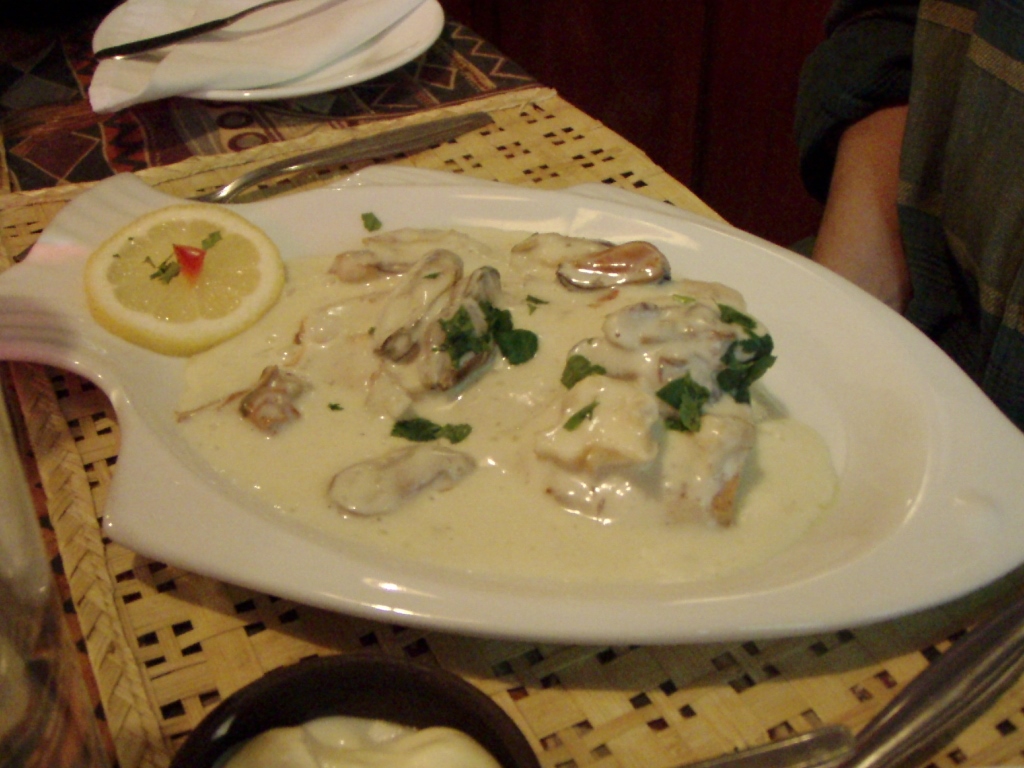 Punta Arenas, cusk-eel in margarita sauce (congrio margarita)
Punta Arenas, cusk-eel in margarita sauce (congrio margarita)
Still, the experience would not have been complete if we had not accompanied the food with some great Chilean wine! As opposed to the temperature outside, the one in the restaurant was quite high thanks to a furnace near us and this wine certainly helped with the sensation of warmth.
After great chatting, food and drinks, at some point we finally went “home,” i.e., to Cecilia’s house. She and her son Maxi were great hosts, we had excellent and comfortable accommodation at their place, so we had good sleep and rest that night.